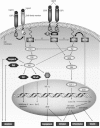New approaches to EGFR inhibition for locally advanced or metastatic squamous cell carcinoma of the head and neck (SCCHN)
- PMID: 22252310
- PMCID: PMC3466428
- DOI: 10.1007/s12032-012-0159-2
New approaches to EGFR inhibition for locally advanced or metastatic squamous cell carcinoma of the head and neck (SCCHN)
Abstract
Despite recent advances in radiotherapy and chemotherapy, survival rates for squamous cell carcinoma of the head and neck (SCCHN) have remained poor. The focus of SCCHN therapy has more recently shifted to the molecular level, particularly the epidermal growth factor receptor (EGFR/ErbB) pathway. Several agents that target the EGFR pathway, including monoclonal antibodies and tyrosine kinase inhibitors, are under investigation for SCCHN. Searches of PubMed and results of key oncology congresses were performed to identify relevant articles and abstracts. The EGFR-targeted monoclonal antibody cetuximab is approved for the treatment of locally advanced SCCHN in combination with radiotherapy, for first-line treatment of recurrent or metastatic SCCHN in combination with platinum-based chemotherapy and 5-fluorouracil, and for recurrent or metastatic SCCHN following progression with platinum-based chemotherapy. Other investigational EGFR-targeted monoclonal antibodies (e.g., panitumumab, nimotuzumab, zalutumumab) are in clinical development for SCCHN. Inhibition of the tyrosine kinase domain of EGFR has also been explored as a therapeutic approach in SCCHN using small-molecule reversible inhibitors, such as gefitinib and erlotinib. However, a key challenge in SCCHN is the development of resistance, and strategies are being pursued to delay or overcome resistance to EGFR-targeted agents. These strategies include development of agents that inhibit multiple ErbB receptors simultaneously (e.g., lapatinib) or that bind multiple ErbB family receptors irreversibly (e.g., afatinib, PF-00299804) and investigation of combinations of agents that target multiple pathways implicated in the pathogenesis of SCCHN. Ongoing large clinical trials are evaluating these emerging agents and combinations for the treatment of SCCHN.
Figures


References
-
- National Comprehensive Cancer Network. NCCN clinical practice guidelines in oncology™. Head and neck cancers. Version 2.2011. http://www.nccn.org/professionals/physician_gls/PDF/head-and-neck.pdf. 2011.
Publication types
MeSH terms
Substances
LinkOut - more resources
Full Text Sources
Medical
Research Materials
Miscellaneous

